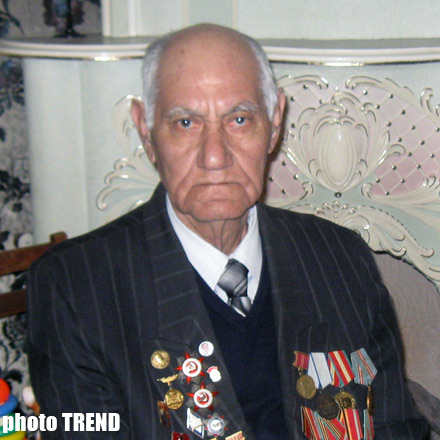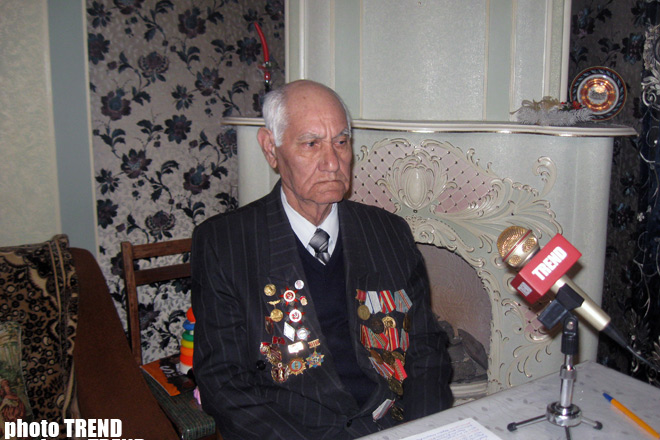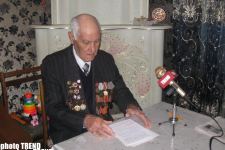Azerbaijan, Baku, May 5 / Trend T.Hajiyev /
Many years have passed since the end of the World War II. This year, we mark the sixty-fifth anniversary of our victory. Although much time has passed since that terrible time, many people continue to grieve over the pain of that war, in the same way that we all rejoice in our victory. About 640,000 Azerbaijanis fought on Soviet front in 1941-1945. The 402nd National Rifle Division was formed in Azerbaijan in August 1941, the 223rd in October, the 416th in March-September 1942, and the 271st in August and September. The 416th Division was named the Honorary Taganrog Division for liberating Taganrog.
The 416th Taganrog Division begin fighting in November 1942 with battles near Mozdok. After liberating the North Caucasus, Rostov and Taganrog, the division took part in the destruction of the Nikopol forces and ensured the release of Nikolayev, Odessa, Chisinau and Warsaw. The division ended its fight in Berlin.
Our interlocutor is Amirali Amiraliyev, an ex-soldier of the 416th Taganrog Division. He was awarded the Suvorov Red Banner Order, and other medals for bravery in battle.
Amiraliyev recalls his first moments on the front.
Remembering the war through Amiraliyev's eyes, one can understand the pain of war and the suffering he endured. He is a man of the utmost courage, who has experience the true joy of victory.
"Thinking about those days, the events come alive once again right before my eyes," Amiraliyev said. "As WWII was a war of technology, the main objective in military terms on the southern front was to capture Baku. The reason for this was that Baku provided 75-80 percent of the fuel of the entire Soviet army. As a result, the national divisions formed in Azerbaijan to strengthen the defenses of the Caucasus. I, too, March 8, headed to the front in the 416th Division in 1942."
Amiraliyev recounted his memories of those days to Trend:
"I was in the tenth grade. When we heard about the start of the war, we all turned to the military commissariat to voluntarily go to the front. We still were not allowed to go as we were in high school. But we passed our exams early in March 1942 and left for the front. The Nazi army had already moved to the North Caucasus. The center of the 416th Division was the Ujar region.
"Draftees from the surrounding areas gathered there. After the division was formed in February-March 1942, we were sent to three-month training. In July, we were dispatched to defend the North Caucasus. We first fought the Germans Nov. 30 at Mozdok. The battle turned out well for us and thus began the honorable path of the 416th Taganrog Division."
Amiraliyev said many of his colleagues were only 18 years old when they reached the front.
"We didn't feel any fear," he said. "We didn't know what fear was. In those days, military training was performed at the highest level. There was a great belief in the state. We did not feel any fear and in the most difficult situations we charged into the fight after we heard the order 'For the Motherland.' Our love of the country triumphed over all other feelings. Only liberating our motherland from occupation was our goal. People who fight in battles don't feel the fear of death."
Amiraliyev recalled Mir Jafar Bagirov's speech before the first battle.
"Mir Jafar Bagirov said the Azerbaijani people have heroes like Javanshir and Babak," he said. "We are the descendants of these heroes. The Azerbaijani nation is the most honest, courageous and heroic nation. It will never allow anyone to harm the honor of its family. Our mothers and sisters were behind us. Defeat would have meant that the fascists could enter our motherland. We would not allow the fascists to enter our homeland. These words gave us strength."
Fighting path of Azerbaijan's 416 Taganrog division
According to Amiraliyev, Central Committee of the Communist Party of Azerbaijan was instructed to protect the southern border during the war. Therefore, national divisions were formed in Azerbaijan.
"The first fight, which I attended, was in the winter of 1942 around Mozdok. The Germans excelled us in number of troops and military equipment. Due to the fact that most of the soldiers of our division were teenagers, the Germans were also physically stronger than our soldiers. I was a machine-gunner. My comrades were killed before my eyes. Corpsmen were unable to help the wounded. But we remained on our foot and the German army was forced to step back," the veteran of the war remembers.
Amiraliyev said that the fight path of Azerbaijan's 416 Taganrog division ran from Mozdok to Berlin
"Due to the fact that this division had shown heroism in the early years, fascist army could not resist it. In the winter of 1942, our division liberated the Northern Caucasus. In spring and summer of 1943 it released the stations of St. George, Zolotorev and Soviet. In August 1943, we liberated the city of Taganrog. In connection with this event, the Supreme Council of the USSR named our division after the city of Taganrog.
In general, during the war, our division received gratitude of the Supreme Command 12 times, WWII participant said.
"I was wounded and stayed in the field during two days"
Amiraliyev talked about his wound during the war.
"There are different fates in the war. There are people who are fighting for 3-4 years, and nothing happens with them. But there are also people who are killed at the first battle. At that time, our division moved forward. Nurses saw some wounded. But some of them were wounded on the field and died.
The same situation happened with me. During the battle the sounds of tanks, cannons and machine guns mingled with each other. People were killed before my eyes. A mine exploded and wounded my leg. The pain was unbearable. No one could break away from the battlefield and help me. Unfortunately, I did not met a doctor. The division was advancing, and I stayed behind.
Thus, being wounded I spent two days in the field. Crawling, I was able to reach the road. I could not get up cars, so cars did not notice me. Finally, I crawled to the middle of the road and lay there. One of cars, delivering ammunition to the front, stopped. I was brought to the station Naursk. From there I was sent to the clinic. They set up a medical card and sent me with other wounded by train.
When the train stopped at another station, people said that it was Makhachkala. About 50 wounded were detrained. I thought that the next stop of this train will be in Azerbaijan. So I went back to the train and took my seat. After two months of treatment in Baku, I was sent to fight in Novorossiysk. I participated in the liberation of the city. In this battle I was wounded in the arm."
"Armenian Nazis committed atrocities that are much worse than the atrocities of Hitler's Nazis."
According to a veteran of the war, entering the liberated towns, they saw that these towns remained in normal condition.
"I asked the population of these cities about information we talked at school that the Germans burn, loot and destroy occupied cities. I can see that none of these buildings has no bullet holes. Local people said that the German army simply went away.
I want to say that they did not attack innocent civilians. They punished only those waging a guerrilla war. Pay attention to the difference between Nazi Germany and Armenia. Armenians have destroyed the population of the occupied Azerbaijani towns and destroyed the towns. Khojaly and Agdam towns and all other territories under occupation are an example of this. People do not live on the lands occupied by Armenians. The walls and stones of these towns are removed.
Armenian Nazis committed atrocities that are much worse than atrocities of Hitler's Nazis."
Amirali Amiraliyev got many medals.
Amiraliyev said that his greatest reward in the war was the news about the end of the war.
"Due to injuries I was unable to reach Berlin as part of our division. But the day, when I heard the news of the victory, was the happiest day in my life, because our efforts were not made in vain. Blood was not left on the ground. Moreover, I was awarded with a number of medals by the state. Supreme Commander thanked me for the courage shown in battle, for the liberation of the Caucasus in the WWII. I was awarded with the medal for bravery shown during the liberation of the city of Taganrog. I was awarded with the medal of victory of the first and second degrees. I got two medals for fighting for the liberation of Ukraine," he said.










